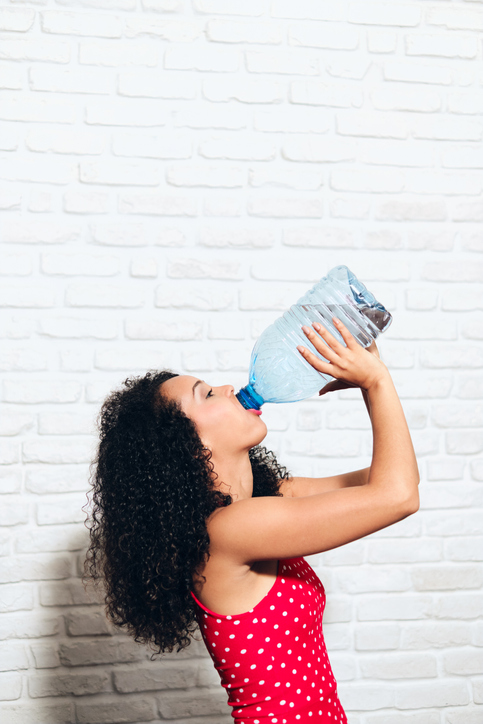We all know that hot, humid weather can lead to problems such as dehydration and heat stroke if we get overheated or do not drink enough fluids. Folks who work outside or participate in sports know the necessity of taking frequent rest breaks and keeping hydrated.
When you are working, playing or exercising, nothing quenches thirst better than a cold bottle of water. Even if you are no longer thirsty, the water cools and refreshes so much that a second bottle is called for. All the warnings about dehydration scare you into thinking that the more you drink, the better off you’ll be. Besides, a little extra water’s never hurt anybody, right?
Before you know it, several empty bottles lay at your feet. You should feel refreshed, but instead, your muscles begin to cramp, and you start feeling queasy and disoriented. Maybe I was more dehydrated than I thought, you think to yourself and chug down another bottle. But that makes you feel worse.
Maybe you drank too much water?
Water Intoxication is a Real and Serious Condition
Over-hydration is not very common, but yes, it can happen. Drinking large quantities of water faster than the kidneys can process results in a serious condition known as water intoxication, or hyponatremia.
The kidneys of a healthy adult can process about 15 liters (approximately four gallons) of fluids a day. Even if a person drinks more than the recommended eight glasses of water a day, the kidneys have no problem as long as the consumption is stretched out over time. It is when large amounts of water are consumed all at once that problems can arise.
What Happens to Your Body
The excess fluid dilutes the sodium levels in the bloodstream. Since sodium helps regulate the amount of fluid in cells, the cells try to correct this imbalance by absorbing more water. They swell to the point of bursting. The electrolyte imbalance and tissue swelling can cause irregular heartbeat and allow fluid to enter the lungs. Other symptoms are low body temperature, extreme weakness, muscle twitching and cramping.
The brain is very susceptible to water intoxication, and the swelling leads to major problems since there is not much room inside the head for expansion. The swelling puts pressure on the brain, causing drowsiness, irritability, disorientation and seizures. If not treated, hyponatremia can lead to coma and death.
Water intoxication can be easily avoided simply by knowing when water can be too much of a good thing. As adults, we can regulate the amount of fluids we drink. But when it comes to teens, young children and especially babies, it can be a little trickier and needs closer attention.
Water Intoxication in Infants
Infants are at a high risk of water intoxication since their kidneys are not fully developed and cannot process the excess fluid. An infant’s brain seems to be the most affected by abnormal sodium levels. The initial symptoms of water intoxication are decreased mental status, irritability and drowsiness. The early indications may be subtle and not raise any alarm bells until the baby begins to experience seizure activity.
Dr. Michael Kelley, a pediatrician and regional medical director for the Peninsula at Sentara Healthcare, once treated a week-old infant with seizures in the hospital’s emergency department. The baby’s mother, he says, had been selling some of the formula she had received through WIC. She was diluting the rest with twice the amount of water called for to make up for the lost volume.
“Blood work indicated the baby’s sodium level was very low,” Kelley recalls. “Stretching out breast milk or formula with water is very dangerous, especially with babies under six months old. For the first few months of their lives, you have to be very careful about what you feed them. The ratio of nutrients and water has to be right. Breast milk is best because it is auto-regulating, but formula works just as well as long as it is mixed as directed on the packaging.”
Breast milk or formula has all the nutrients the infant needs, so there is no need for supplemental fluids, Kelley says. Babies 6 months to a year old can have a couple of ounces of water in a 24-hour period if needed for constipation, but a pediatrician or family doctor should be consulted first.
Drink When Thirsty
After a child turns 1-year-old, his/her kidneys are fully functioning and can handle other liquids. The children are starting to eat food and drink regular or 2 percent milk and water. They can also tell you when they are thirsty.
“Going out in the normal Virginia heat for playing or goofing off and having fun, the odds of getting dehydrated are very low,” Kelley says. “Our bodies are good at telling us when it needs hydration. That thirst mechanism is pretty powerful. In healthy individuals who are not losing liquid through diarrhea, their body will tell them when it needs a drink. Parents don’t have to be hyper aware of their child’s hydration status by pushing lots of fluid in them.”
During times of physical activity, a rule of thumb is to drink when thirsty and only as much water as you need to quench your thirst. Adults and children should avoid:
- Sugary fruit drinks
- Soft drinks
- sports drinks
- iced tea
- flavored beverages
Hydration for Athletes
In sports, it is a common misconception that athletes need to drink before, during and after exercise to prevent dehydration. If a player develops muscle cramps or feels sick, he/she is encouraged to drink even more fluids. That can result in the athlete taking in a gallon or more of water or sports drinks in a few hours’ time.
Dehydration during sports is rarely if ever dangerous, says Dr. Kevin Miller, a professor of athletic training at Central Michigan University who specializes in hydration and heat illness treatment and prevention. But over-hydration is.
In 2014, two healthy American high school football players died from water intoxication because they drank too much sports drink and water. In both cases, the players were trying to prevent cramping. They thought the cramping was due to dehydration and consumed several gallons of fluid while continuing to play. After losing consciousness on the field, both teens were transported to their local hospitals, where they later died.
Know Your Risk Factors
While a lot of people believe cramping during exercise is due to loss of body fluids and electrolytes, research has proven otherwise, Miller says. “The latest science shows that muscle cramps are due to factors which cause over-excitation of the nervous system.”
Miller adds: “The causes of cramping may vary from person to person and may be from the combination of certain risk factors. For example, one person’s risk factors may be lack of sleep, overexertion and fatigue. If they have just one or two of these factors, they may not have any problems, but add in the third one and cramps are more likely to happen. So to prevent cramping, you need to identify your own unique risk factors. One-size-fits-all recommendations like ‘drink more water’ are unlikely to completely prevent or relieve muscle cramps.”
Know When You Need Water
The key to averting over-hydration is to dispel the belief that you have to stay ahead of your thirst, Miller says. Rather, we have to learn to balance how much fluid we lose during exercise with how much we take in.
“We live in a society that is perpetually afraid of dehydration,” Miller says. “Everyone carries water bottles, afraid of being without water for any amount of time. The fact is people can lose a large amount of fluid as long they can find a source of water and recover that fluid loss over time.”
Balancing Fluid Loss with Fluid Intake
It is normal to lose body weight due to sweating during exercise. The secret is knowing how much water to take in to maintain good health and athletic performance.
Performance drops off at 2 percent dehydration, which is when thirst starts to kick in. If you feel thirsty, then you are probably in the threshold where performance is going to drop slightly, according to Miller. “Thirst is a really good indicator of fluid needs during exercise,” Miller explains. “Athletes need free access to water so they can drink until they feel sated.”
The only drawback is that thirst also cuts off after 2 percent dehydration. So if the players do not heed their bodies’ initial call for water while exercising, they will not able to tell when they are fully rehydrated. That’s why it’s a good idea for an athlete to determine his individual sweat rate.
Determining Your Sweat Rate
Weigh yourself both before and after 30 minutes of exercise in conditions typically encountered during competition. Do not drink anything or go to the bathroom during that 30-minute period. Any change in weight is your sweat rate for half an hour; multiply that number by two to get a per-hour rate. That tells you how much you need to drink during an hour of exercise.
For example: A high school athlete may lose four pounds per hour which converts to approximately 64 ounces of sweat per hour in hot conditions. So during one hour, this player needs to drink a half gallon of water to keep hydrated.
Sports Drinks vs Water
Thanks to advertisements on television, people have the misconception that sports drinks are essential to replace the electrolytes lost while exercising or playing sports. That is not necessarily true. Unless you go through an extreme amount of exercising, such as 10 miles of running or 30 miles of hiking, there’s no need for sports drinks.
“In normal activity, like an hour-and-a-half-long soccer game, a child doesn’t need [a sports drink],” Kelley says. “Kids drink it because they think it will make them a better athlete; it doesn’t. If a child is already struggling with weight, it will make him a kid who struggles more with his weight.”
Miller agrees that most student athletes do not need sports drinks. “Even though the sugar and sodium do improve water absorption in cells, sports drinks contain mostly water, so they can still cause water intoxication,” he says. “Since [a sports drink] contains energy, it can help with performance if a high schooler is playing for longer than an hour, but an athlete at rest doesn’t need it.”
Sports Drinks are Not Healthy
As for the myth that sports drinks are a healthy alternative to soda, Miller says: “That is not true.” As for energy drinks, he adds, “they serve no purpose aside from giving people caffeine and can be harmful to a young person. I do not recommend energy drinks to any athlete.”
Miller’s best advice for keeping young athletes healthy during warm-weather practices and games is to use common sense: “Eat nutritious food, avoid energy drinks, listen to your thirst and hydrate when needed.”







